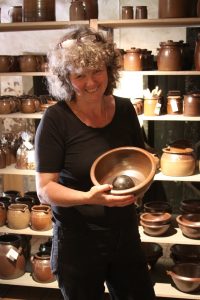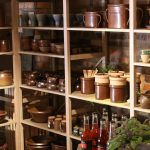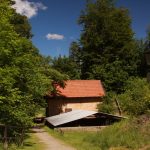This was originally a site where pottery was made with local clay taken from the surrounding land. The original buildings date to 1864. In the late 1980’s, occupational therapist Åsa Orrmell was shown this property by a friend. She had no formal training in what would come next. The site was abandoned and in serious disarray with major work needing to be done before it would become a working stoneware factory again. In 1988 with help of friends, Asa reopened the stoneware factory.
Today Åsa overseas this rural center of creativity and is the driving force behind its success and its central mission to educate about and preserve the unique history of the property. She wants to bring to life in a contemporary setting – the beauty of the past. As she says, “if we don’t preserve the past and those ways of life, we will lose this forever.”
The clay for her studio used to be taken from the property until very recently – and then processed with water through the historical equipment on site. Today the clay comes from the local region. Coal was mined from this part of Sweden until the 1970’s – and used to heat the large kiln on site. In fact, coal is still used to heat this massive oven but today she has it shipped in from Poland.
Walking into this potter’s work space is like walking back into time. It even smells ancient here. Piles of pottery line old wooden shelves, ancient potters wheels sit waiting to be used, sunlight creeps in but doesn’t quite get a foothold, original bricks line the walls and piles of coal sit in the corners near the kiln.
This kiln is the centerpiece of her operations – despite the fact that it is only used four times a year. All the pots and clay ware from the previous months are stacked up in side until capacity has been reached. It is then heated up to 1300 degrees Celsius – during this time large piles of coal are brought in and surround much of the kiln – and are then used as needed. This is a serious operation; 7 tons of coal is used each time the kiln is fired and 70 kilograms of salt are added which then vaporize and add unique glazing effects to the pottery.
This gigantic kiln takes 2 weeks to entirely cool down! When it is empty it can hold up to 20 people inside.
Appointments for pottery classes must be made ahead of time. Because it often takes several months before the pieces are cured and glazed in the kiln – Åsa will ship pieces. If you don’t want to wait for pottery to be cured – a gallery on site has a variety of pieces for sale.With customers and visitor’s looking for culinary options in the vicinity it made a lot of sense to open a restaurant on site. Åsa converted an old storehouse, hired a chef and now serves lunch here. Using local products and ingredients is a primary goal of this restaurant – from the wash-bin and waste basket in the restroom (built on site) to some kitchen ware to herbs and other vegetables grown on site. Care, creativity and quality are essential ingredients to every meal served here.
One of Åsa’s sayings is, “waste can find a use somewhere” – she puts this into practice when you enter the restaurant. A metal grill covers a small pile of glazed pottery shards which are arranged artistically. A small creek runs through the property and even directly beneath the restaurant. Asa cut out a square part of the floor and replaced it with thick glass. During the autumn – salmon will swim up this stream and you can see them spawning directly underneath!
Dinosaurs used to walk this property 180 million years ago. Their footprints are now well preserved – there is a replica of one in the gallery. Forty pairs of tracks have been found on the property.
After all the time an energy she has put into the site – the important thing is her work here is still “fun”. Åsa enjoys meeting and interacting with visitors – it is important to her that her guests have an enriching experience and learn something about history and culture in the process.
For more information visit: www.wallakra.com (site currently in Swedish)












Leave a Reply